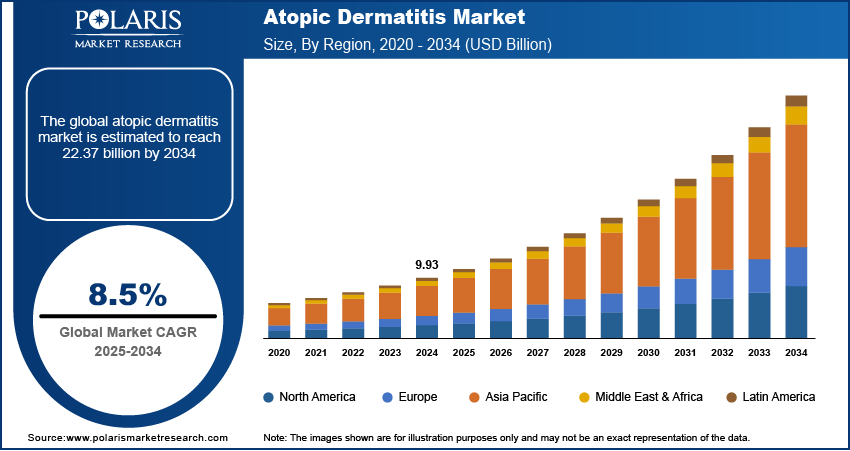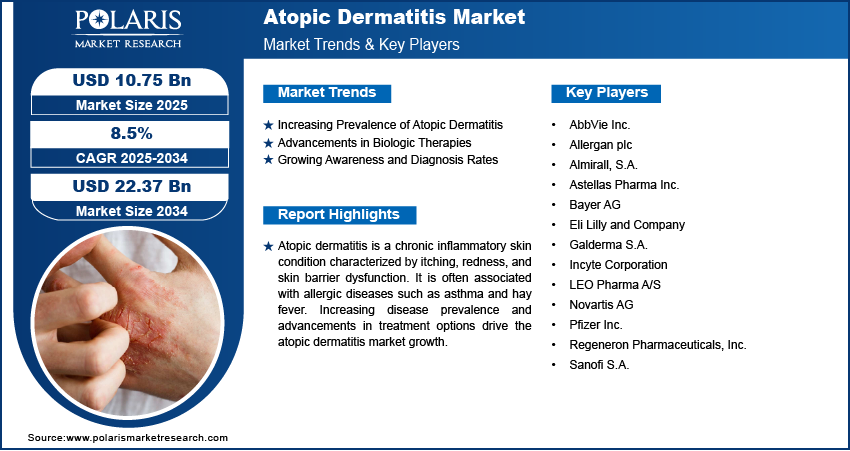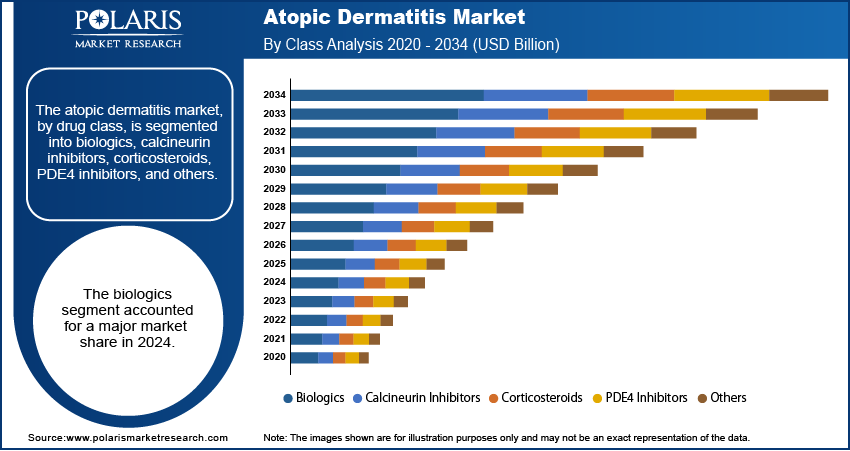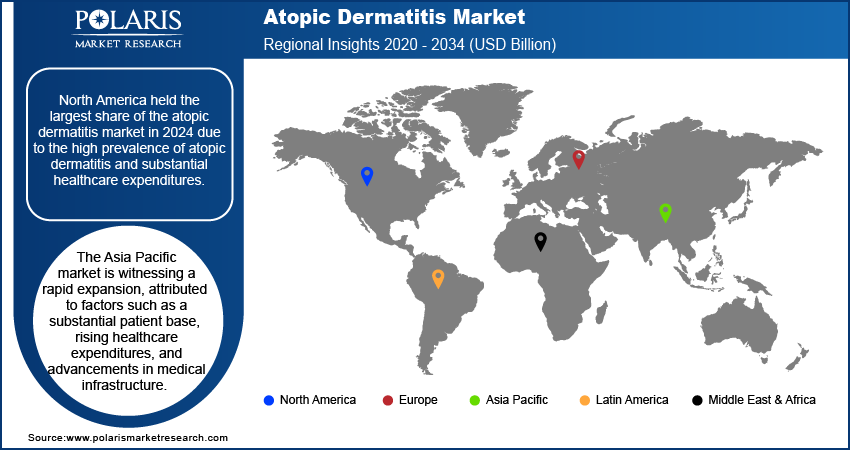
Atopic Dermatitis Market Size, Share, Trends, Industry Analysis Report: By Drug Class (Biologics, Calcineurin Inhibitors, Corticosteroids, PDE4 Inhibitors, and Others), Route of Administration, Therapy, and Region (North America, Europe, Asia Pacific, Latin America, and Middle East & Africa) – Market Forecast, 2025–2034
- Published Date:Apr-2025
- Pages: 117
- Format: PDF
- Report ID: PM1317
- Base Year: 2024
- Historical Data: 2020-2023
Atopic Dermatitis Market Overview
The atopic dermatitis market size was valued at USD 9.93 billion in 2024. The market is projected to grow from USD 10.75 billion in 2025 to USD 22.37 billion by 2034, exhibiting a CAGR of 8.5% during 2025–2034.
The atopic dermatitis market refers to the global industry focused on the diagnosis, treatment, and management of atopic dermatitis, a chronic inflammatory skin condition. Market growth is driven by the increasing prevalence of disease, rising awareness of dermatological disorders, and advancements in biologic therapies.
Key atopic dermatitis market trends include the development of targeted immunomodulators, the expansion of topical and systemic treatment options, and the growing adoption of digital health solutions for disease management. Additionally, the rising investments in research and development by pharmaceutical companies and regulatory approvals for novel therapies contribute to the atopic dermatitis market development.

To Understand More About this Research: Request a Free Sample Report
Atopic Dermatitis Market Dynamics
Increasing Prevalence of Atopic Dermatitis
There is a rising number of atopic dermatitis cases across the world. According to the International Eczema Council, approximately 223 million individuals worldwide were affected by atopic dermatitis in 2022. This escalating prevalence highlights the growing demand for effective treatments and management strategies. Thus, the rising prevalence of atopic dermatitis fuels atopic dermatitis market demand.
Advancements in Biologic Therapies
Innovations in biologic treatments have transformed the therapeutic landscape for atopic dermatitis. Biotechnology and pharmaceutical companies are focusing on developing novel therapeutic options, including targeted biologics, small molecule inhibitors, and immunomodulators. These innovative drugs offer enhanced efficacy and safety profiles. Hence, rising advancements in biologic therapies drive the atopic dermatitis market growth.
Growing Awareness and Diagnosis Rates
Enhanced public awareness and improved diagnostic capabilities contribute to the atopic dermatitis market expansion. Initiatives aimed at educating both healthcare professionals and the public about early detection and management have led to increased diagnosis rates. This high awareness facilitates timely intervention, thereby expanding the patient pool seeking treatment.

Atopic Dermatitis Market Segment Insights
Atopic Dermatitis Market Assessment by Drug Class
The atopic dermatitis market, by drug class, is segmented into biologics, calcineurin inhibitors, corticosteroids, PDE4 inhibitors, and others. The biologics segment accounted for a major atopic dermatitis market share in 2024. These advanced therapies, such as interleukin inhibitors, are primarily prescribed for severe cases unresponsive to prior systemic treatments, offering significant clinical advantages over traditional topical medications.
Atopic Dermatitis Market Evaluation by Route of Administration
The atopic dermatitis market, based on route of administration, is segmented into topical, injectable, and oral. The injectable segment held the largest market share in 2024. This dominance is largely attributed to the widespread adoption of injectable biologic therapies, such as Dupilumab, which have demonstrated substantial efficacy in managing moderate to severe cases.
The tropical segment is estimated to grow at the fastest pace in the coming years. Topical treatments, including creams, gels, and lotions, are commonly utilized due to their ease of application and direct action on affected skin areas. This route of administration is often preferred for mild to moderate atopic dermatitis due to its accessibility and lower systemic side effects.

Atopic Dermatitis Market Regional Outlook
By region, the atopic dermatitis market report provides insights into North America, Europe, Asia Pacific, Latin America, and the Middle East & Africa. North America accounted for a major share of the global atopic dermatitis market revenue in 2024 due to the high prevalence of atopic dermatitis and substantial healthcare expenditures. According to the National Eczema Association, in the US, atopic dermatitis affects about 9.6 million children and 16.5 million adults. This significant patient population drives the demand for effective treatments. Additionally, the region benefits from the introduction of advanced therapies and favorable regulatory support, as evidenced by recent FDA approvals for innovative treatments. These factors collectively contribute to North America's dominant position in the market.
The Europe atopic dermatitis market is experiencing robust growth, driven by a notable prevalence of atopic dermatitis and proactive initiatives by both governmental bodies and industry stakeholders. Estimates by the European Medicines Agency indicate that up to 7% of adults in Europe are affected by atopic dermatitis, with approximately 30% of these cases classified as moderate to severe. This significant patient population has led to increased demand for effective treatments, thereby fueling atopic dermatitis market expansion. Additionally, strategic endeavors, such as the introduction of advanced biologic therapies, are enhancing treatment options and accessibility for patients across the region.
The Asia Pacific atopic dermatitis market is witnessing a rapid expansion, attributed to factors such as a substantial patient base, rising healthcare expenditures, and advancements in medical infrastructure. The regional market growth is further supported by increased awareness of dermatological conditions and the adoption of innovative treatment modalities, including dermatology drugs, positioning Asia Pacific as a significant contributor to the global market.

Atopic Dermatitis Market – Key Players and Competitive Analysis Report
The atopic dermatitis market comprises several key pharmaceutical companies actively involved in developing and marketing treatments for this chronic skin conditions. A few notable participants include Pfizer Inc.; Sanofi S.A.; AbbVie Inc.; Galderma S.A.; Eli Lilly and Company; Regeneron Pharmaceuticals, Inc.; LEO Pharma A/S; Otsuka Pharmaceutical Co., Ltd.; Novartis AG; and Incyte Corporation. These companies have made significant contributions through research and development of various therapeutic options, including biologics, small molecule inhibitors, and topical treatments.
Additional contributors to the atopic dermatitis market are Astellas Pharma Inc., Bayer AG, Allergan plc, and Almirall, S.A. These organizations have expanded the range of available treatments, addressing diverse patient needs and preferences. Their efforts encompass the development of innovative therapies and the enhancement of existing treatment modalities to improve patient outcomes.
The competitive landscape is characterized by ongoing research initiatives, strategic collaborations, and a focus on addressing unmet medical needs. Companies are investing in clinical trials to evaluate the efficacy and safety of novel compounds, aiming to introduce more effective and targeted therapies. This dynamic environment fosters innovation and offers patients access to a broader spectrum of treatment options, ultimately contributing to improved management of atopic dermatitis.
Pfizer Inc. is one of the world's largest and most renowned pharmaceutical companies, with a rich history dating back to its founding in 1849 by Charles Pfizer and Charles F. Erhart in New York City. The company is headquartered at The Spiral in Manhattan, New York City, and is led by CEO Albert Bourla. It is committed to applying science and global resources to improve health and well-being by developing, manufacturing, and marketing a wide range of medicines and vaccines across various therapeutic areas, including immunology, oncology, cardiology, endocrinology, and neurology. Pfizer Inc. has made significant strides in addressing atopic dermatitis (AD), a chronic inflammatory skin condition characterized by intense itching, redness, and skin barrier defects. Pfizer's most notable contribution to the treatment of moderate-to-severe AD is abrocitinib, marketed under the brand name CIBINQO.
Sanofi S.A. is a French multinational pharmaceutical company headquartered in Paris, France, and is one of the world’s largest healthcare organizations by prescription sales. Established in 1973, the company operates across three principal segments: pharmaceuticals, human vaccines, and animal health. Its portfolio includes treatments for cancer, rare diseases, multiple sclerosis, diabetes, cardiovascular conditions, and vaccines for bacterial and viral diseases. Sanofi also provides consumer healthcare products such as allergy remedies, vitamins, and pain relief medications. In the field of atopic dermatitis (AD), Sanofi has made contributions with its biologic drug Dupixent (dupilumab). Developed in collaboration with Regeneron Pharmaceuticals, Dupixent is an interleukin-4 receptor antagonist that targets the underlying inflammation associated with AD.
List of Key Companies in Atopic Dermatitis Market
- AbbVie Inc.
- Allergan plc
- Almirall, S.A.
- Astellas Pharma Inc.
- Bayer AG
- Eli Lilly and Company
- Galderma S.A.
- Incyte Corporation
- LEO Pharma A/S
- Novartis AG
- Pfizer Inc.
- Regeneron Pharmaceuticals, Inc.
- Sanofi S.A.
Atopic Dermatitis Industry Developments
- In July 2024, Kymera Therapeutics, a clinical-stage biopharmaceutical company, reported that Sanofi would expand a Phase 2 trial of KT-474, an investigational drug for autoimmune skin diseases, including atopic dermatitis, following positive safety and efficacy reviews.
- In July 2024, Arcutis Biotherapeutics, Inc., a commercial-stage biopharmaceutical company focused on developing meaningful innovations in immuno-dermatology, announced that the U.S. Food and Drug Administration (FDA) has approved the supplemental new drug application (sNDA) for ZORYVE (roflumilast) cream, 0.15%, for the treatment of mild to moderate atopic dermatitis in adult and pediatric patients aged 6 years and above.
- In January 2024, Glenmark Pharmaceuticals Ltd. and Pfizer joined hands to launch abrocitinib, a first-of-its-kind oral advanced systemic treatment for moderate-to-severe atopic dermatitis (AD), in India.
Atopic Dermatitis Market Segmentation
By Drug Class Outlook (Revenue – USD Billion, 2020–2034)
- Biologics
- Calcineurin Inhibitors
- Corticosteroids
- PDE4 Inhibitors
- Others
By Route of Administration Outlook (Revenue – USD Billion, 2020–2034)
- Topical
- Injectable
- Oral
By Therapy Outlook (Revenue – USD Billion, 2020–2034)
- Photo Therapy
- Directed Therapy
By Regional Outlook (Revenue – USD Billion, 2020–2034)
- North America
- US
- Canada
- Europe
- Germany
- France
- UK
- Italy
- Spain
- Netherlands
- Russia
- Rest of Europe
- Asia Pacific
- China
- Japan
- India
- Malaysia
- South Korea
- Indonesia
- Australia
- Vietnam
- Rest of Asia Pacific
- Middle East & Africa
- Saudi Arabia
- UAE
- Israel
- South Africa
- Rest of Middle East & Africa
- Latin America
- Mexico
- Brazil
- Argentina
- Rest of Latin America
Atopic Dermatitis Market Report Scope
|
Report Attributes |
Details |
|
Market Size in 2024 |
USD 9.93 billion |
|
Market Value in 2025 |
USD 10.75 billion |
|
Revenue Forecast by 2034 |
USD 22.37 billion |
|
CAGR |
8.5% from 2025 to 2034 |
|
Base Year |
2024 |
|
Historical Data |
2020–2023 |
|
Forecast Period |
2025–2034 |
|
Quantitative Units |
Revenue in USD billion and CAGR from 2025 to 2034 |
|
Report Coverage |
Revenue Forecast, Market Competitive Landscape, Growth Factors, and Trends |
|
Segments Covered |
|
|
Regional Scope |
|
|
Competitive Landscape |
|
|
Report Format |
|
|
Customization |
Report customization as per your requirements with respect to countries, regions, and segmentation. |
How is the report valuable for an organization?
Workflow/Innovation Strategy: The atopic dermatitis market has been broadly segmented on the basis of drug class, route of administration, and distribution channels. Moreover, the study provides the reader with a detailed understanding of the different segments at both the global and regional levels.
Growth/Marketing Strategy: Companies in the atopic dermatitis market focus on product development, strategic collaborations, and regulatory approvals to expand their market presence. Investments in clinical trials for novel biologics and small molecule inhibitors aim to enhance treatment efficacy. Partnerships with research institutions and acquisitions of smaller biotech firms help strengthen product pipelines. Digital marketing, patient awareness programs, and physician engagement initiatives are used to improve treatment adoption. Expansion into emerging markets through distribution agreements and localized manufacturing further supports market growth.
FAQ's
The market size was valued at USD 9.93 billion in 2024 and is projected to grow to USD 22.37 billion by 2034.
The market is projected to register a CAGR of 8.5% during the forecast period.
North America held the largest share of the market in 2024.
The market comprises several key pharmaceutical companies actively involved in developing and marketing treatments for this chronic skin condition. A few notable participants include AbbVie Inc.; Allergan plc; Almirall, S.A.; Astellas Pharma Inc.; Bayer AG; Eli Lilly and Company; Galderma S.A.; Incyte Corporation; LEO Pharma A/S; Novartis AG; Pfizer Inc.; Regeneron Pharmaceuticals, Inc.; and Sanofi S.A.
The biologics segment accounted for the largest share of the market in 2024.
The injectable segment accounted for the largest share of the market in 2024.
Atopic dermatitis is a chronic inflammatory skin condition characterized by redness, itching, dryness, and irritation. It is a common form of eczema that affects both children and adults, often occurring in individuals with a history of allergies or asthma. The condition results from a combination of genetic, immune system, and environmental factors, leading to a weakened skin barrier and increased sensitivity to irritants. Symptoms can vary in severity, with flare-ups triggered by allergens, stress, weather changes, and skin infections. Treatment options include topical corticosteroids, calcineurin inhibitors, biologics, and lifestyle modifications to manage symptoms and prevent exacerbations.
A few key trends in the market are described below: Increasing Adoption of Biologics: The use of monoclonal antibodies such as dupilumab and other targeted biologics is expanding due to their efficacy in managing moderate to severe atopic dermatitis. Rising Prevalence of Atopic Dermatitis: The growing incidence of atopic dermatitis, particularly in urban regions, is driving demand for advanced treatment options. Advancements in JAK Inhibitors: Small molecule drugs, such as Janus kinase (JAK) inhibitors, are gaining traction as oral alternatives for patients who do not respond to conventional therapies. Focus on Personalized Medicine: Companies are investing in biomarker research to develop tailored treatment approaches based on individual patient responses.
A new company entering the market must focus on developing novel biologics or small molecule inhibitors targeting specific inflammatory pathways to address unmet medical needs. Investing in research for personalized treatment approaches using biomarkers and genetic profiling could offer a competitive edge. Expanding access to affordable therapies, particularly in emerging markets, can help capture a broader patient base. Leveraging digital health solutions, such as AI-driven diagnostics and telemedicine integration, can improve patient management. Additionally, forming strategic partnerships with research institutions and engaging in robust patient awareness programs can enhance market positioning.
Companies manufacturing, distributing, or purchasing atopic dermatitis diagnosis and treatment-related products and other consulting firms must buy the report.
